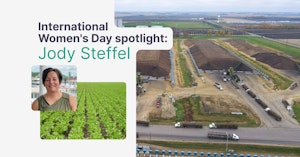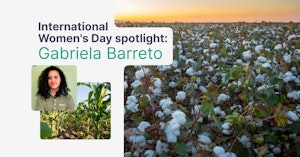The kids are back in school, football season has kicked off, and everyone is asking the question: “So, what did you do this summer?”
The Leaf team was busy this summer. We shipped over 1,000 updates across our platform all designed to make it faster and easier for you to drive end-grower value with the agricultural and machine data you rely on Leaf for. In time for harvest season, your data processing through Leaf should be more powerful, more flexible, and more reliable than it was in June. Check out the highlights below:More customer data
Flexible data configurations
We’ve introduced two new configuration options that let you decide what’s required and what’s optional which means more data being processed and fewer support calls asking “why didn’t my file go through?”
seedRateOptional: Your planting data won’t get rejected if seed rate information is missing. This is important if you are connecting growers who may not have seed meters, yet still want to track the occurrence and spatial extent of planting events.
cropOptional: Your planting data won’t get rejected if crop information is missing. Many growers planting small grains or air seeded crops don’t record crop information in their monitor – now you can process it through Leaf just as easily as all the corn and soybean data that generally does have crop.
Improvements to file conversion including agata, ISO11783, Raven FMIS, DAT, and many more
We started off the summer upgrading our pipelines to use a newly released JD converter (we actually discovered the bug/issue that, thankfully, they then fixed - Thanks JD!). We then made numerous improvements to ISO11783 (ISOXML), Raven FMIS, JD, DAT, AgData and other file formats to handle more ag data edge cases, improve telemetry accuracy, and enhance standardization (especially with respect to as-applied operations). There’s nothing you need to do to enable these improvements. We want your files just to work, and regardless of which equipment produced them, our team of experts is constantly tweaking, updating, and making file conversion better and faster for you.
Improvements to files and operations including better summaries, tank mix support, forage operations
Based on your feedback we’ve made numerous improvements to both files and operations. Application data from a planting operation is now summarized in the planting summary. We’ve made a number of improvements to how tank mixes are calculated. Forage operations are now supported.
New Properties to Track Passes
Regardless if the monitor records it, Leaf now provides the passID on each datapoint in the standardGeojson and standardGeoparquet files as well as the passCount in the summary. These are useful if you want to visualize and help your customer understand their operational efficiency, detect overlaps and control costs. Contact us to enable this feature.
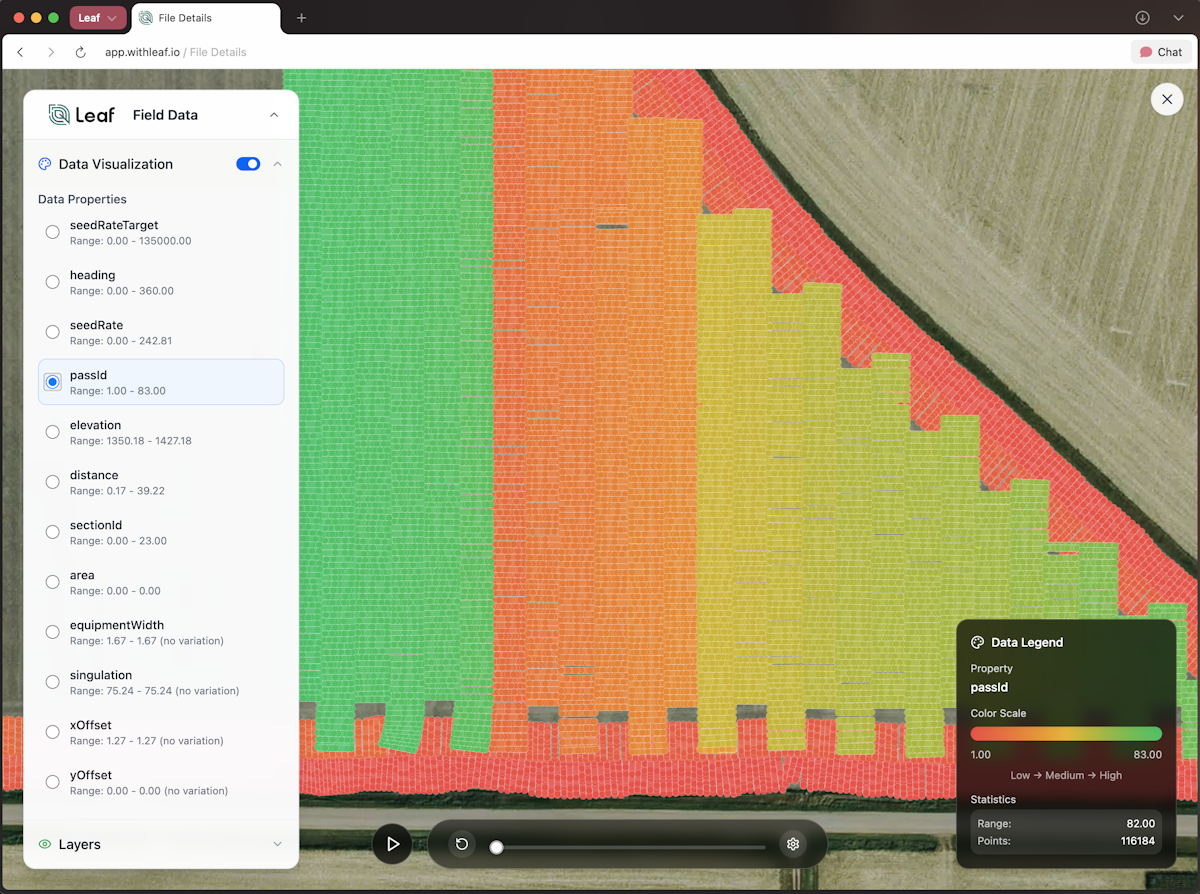
[passID visualized with the new Leaf Dash]
Standardized data interval sampling
If your pipelines expect measurement data at a common interval, say 1 feature per second (1hz), you can now configure Leaf to automatically resample your data to that interval. Contact us to enable this feature.
Variety and crop name inference
By enabling this feature, we’ll attempt to infer what hybrid/variety and crop is actually represented in the data and will augment the standardGeojson with the results of our model including confidence scores. Contact us for additional details or to enable this feature.
Increased Pipeline Transparency, Faster Support
Understand why files were not processed
When a file doesn’t process because of configurations that you have enabled, we now tell you exactly which filtering rule caused the file to not process. You can now use these messages to adjust your configurations and optimize your data processing according to your app and systems’s expectations.
For example, if the the file contained points where RecordingStatus was always Off and you have cleanupStandardGeojson set to true, you’ll now see that the file failed because of “no points passed the filter: recordingStatus == On”, telling you that no points had RecordingStatus On. You might consider turning off cleanUpStandardGeojson by setting it to false if you want these points to be processed and retained.
If you are seeing lots of messages for planting data about “missing properties: seedRate” you might want to consider setting seedRateOptional to true. Or you might want to investigate with your customers why they are sending planting data with no seed rates.
If you are seeing lots of messages for “unsupported operation type: data collection” and you want this data in your app, you might consider setting outOfStandardOperations to true.
Trace files from OEM through Leaf
Ever wonder, "where did this data come from and what happened to it?" Our new file tracing endpoints give you a complete audit trail from raw file at the OEM to final processed data. Contact us to access these endpoints.
New High Definition (HD) Data
Remember how your TV got way better when you upgraded to 4K? Inspired by one of our customers and building on our release of GeoParquet support last year, we did something similar for machine data. We now support:
High definition (HD) output generation
Where the recorded data supports section-level differences in recording attributes (generally planting data) you can now get these section-level values via our standardGeojson and standardGeoparquet outputs. Please talk to us if you’d like to enable HD data for your account.
Polygon output generation
Instead of receiving point data, by setting enablePolygonOutput to true, you can now access data in polygon format. Because of the file size and complexity that comes with polygons, this is only available in GeoParquet so as to keep processing for you (and us) as efficient as possible. Once enabled, you can access polygon output using /files/{id}/polygonGeoparquet.
Between HD output and polygons you can create razor-sharp images of operations – especially planting operations where data is often recorded at a very granular level. Just like when you switched to 4K, you’ll never want to see lower-resolution images again (or give them to your customers). See below for some examples.
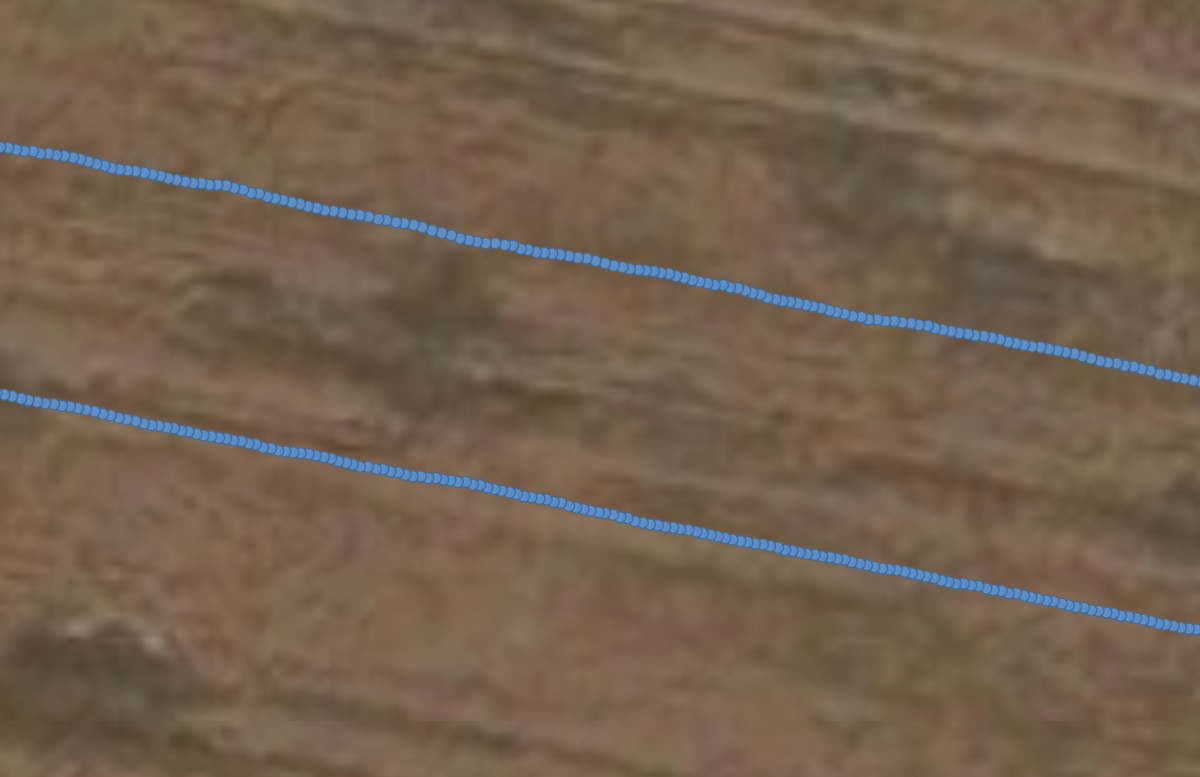
[Standard Definition Points - Planted]

[High Definition Points - Planted]
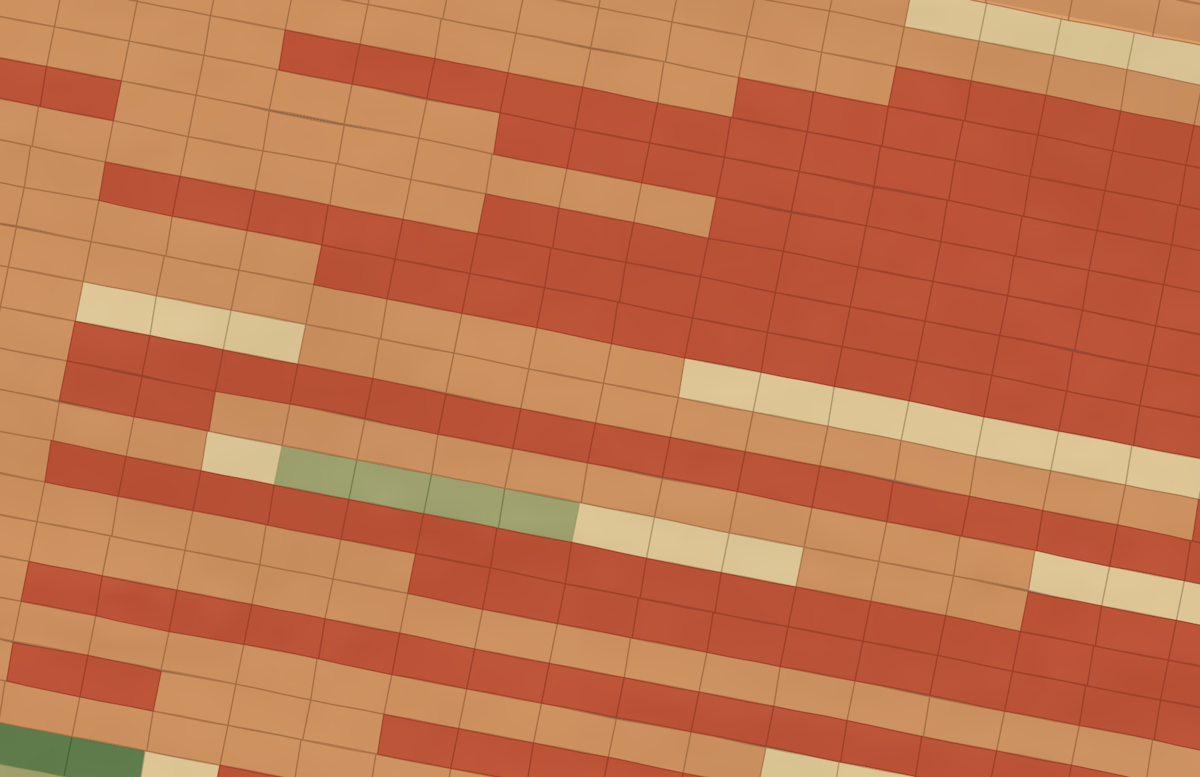
[High Definition Polygons - Planted Zoomed In]
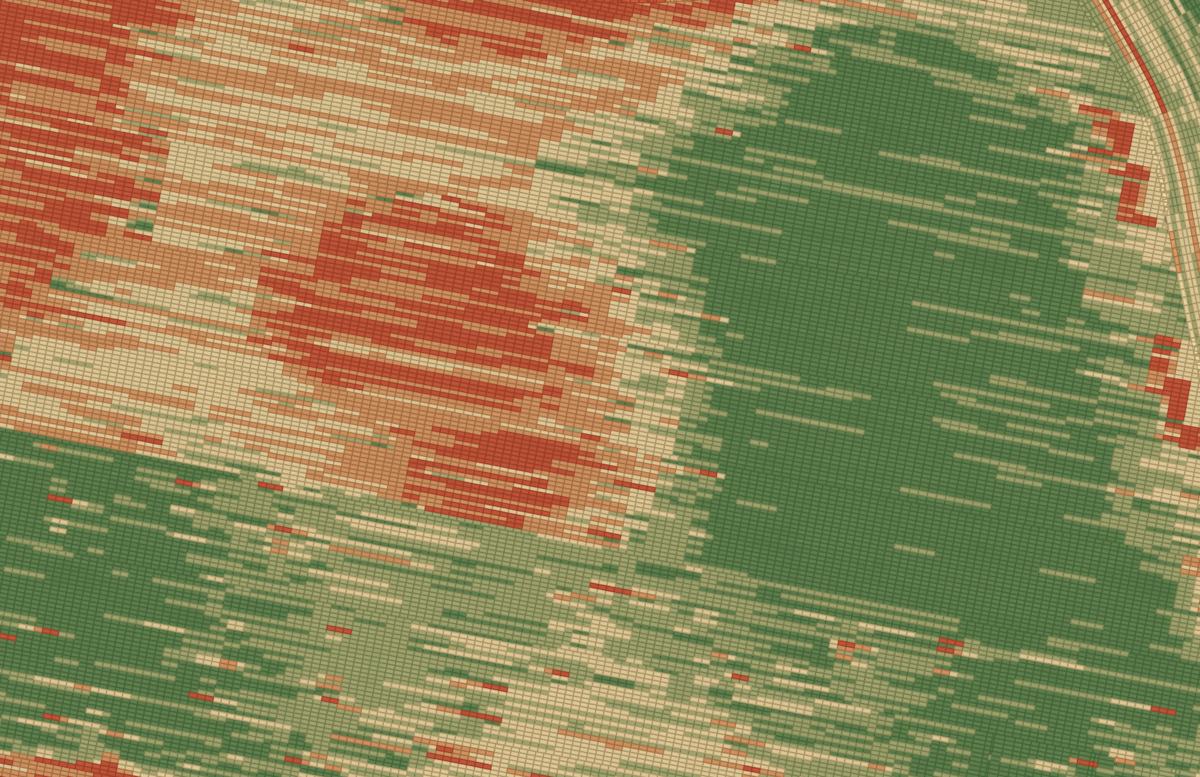
[High Definition Polygons - Planted Zoomed Out]
Beyond APIs: New Ways to Interact with Leaf
We know not all of our customers are software developers and that not all workflows are best served by APIs. We’ve been hard at work building out new ways to interact with Leaf, for humans and AI agents alike.
Leaf Dash: browse and manage your data visually – stop downloading files to SMS or QGIS
With the launch of our new dashboard, you can now interact with our APIs and all of your data, growers, and configurations using a clean, modern and intuitive interface. Our early adopters, and especially their support teams, love how:
- It’s easy it is to visualize and inspect point level data without having to download files to SMS or QGIS
- They can efficiently find data across growers, files, and operations without having to use Postman. Just put in an ID into the comprehensive search box and quickly access what you need.
- They can quickly understand and edit details of their Leaf integration including their pipeline processing configurations, webhook alerts, provider integrations and monitor data processing usage.
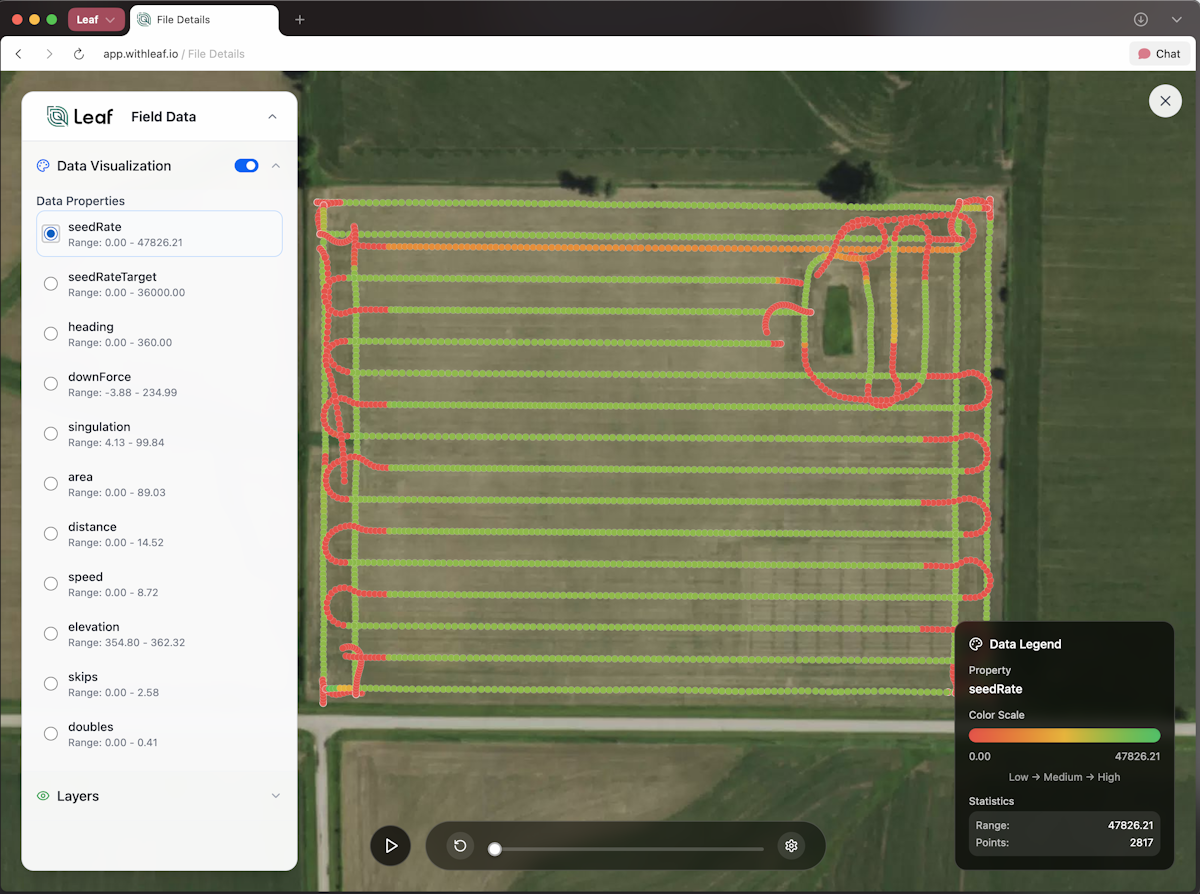
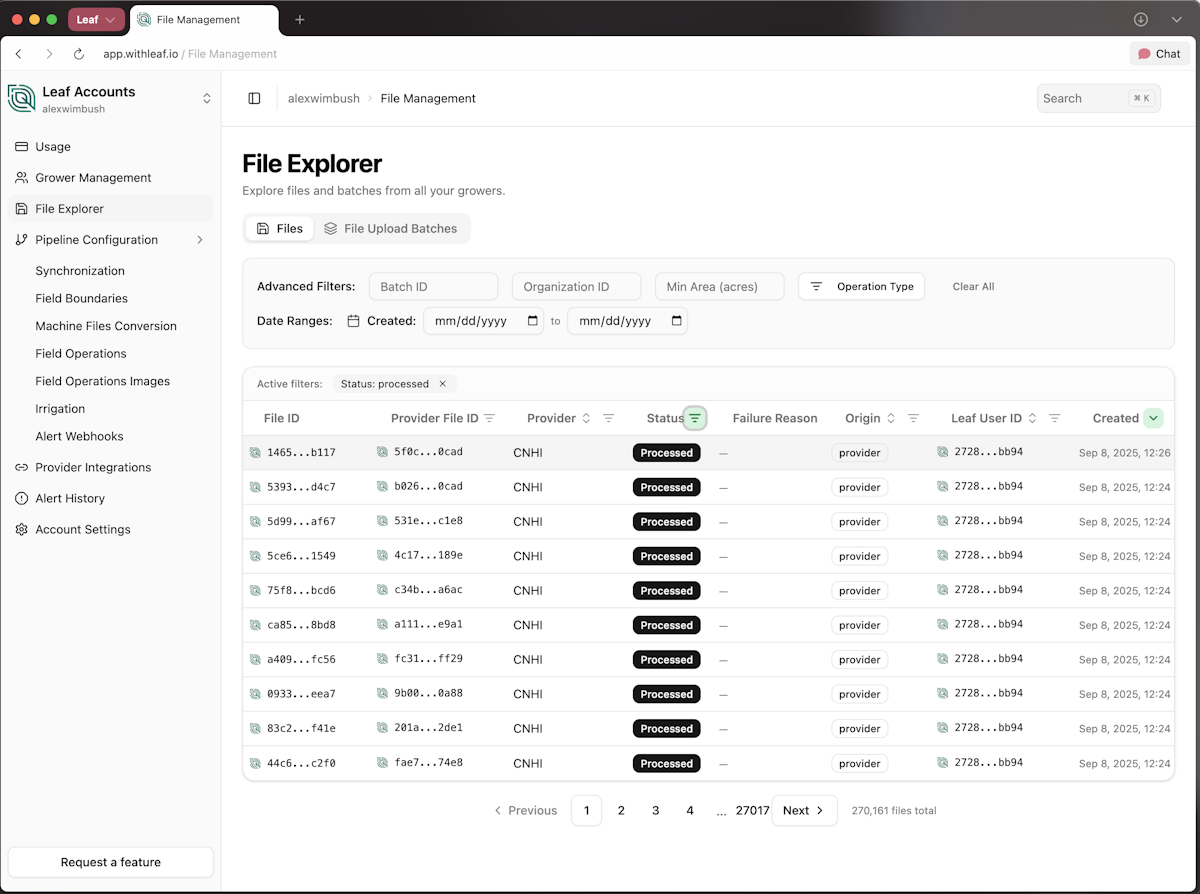
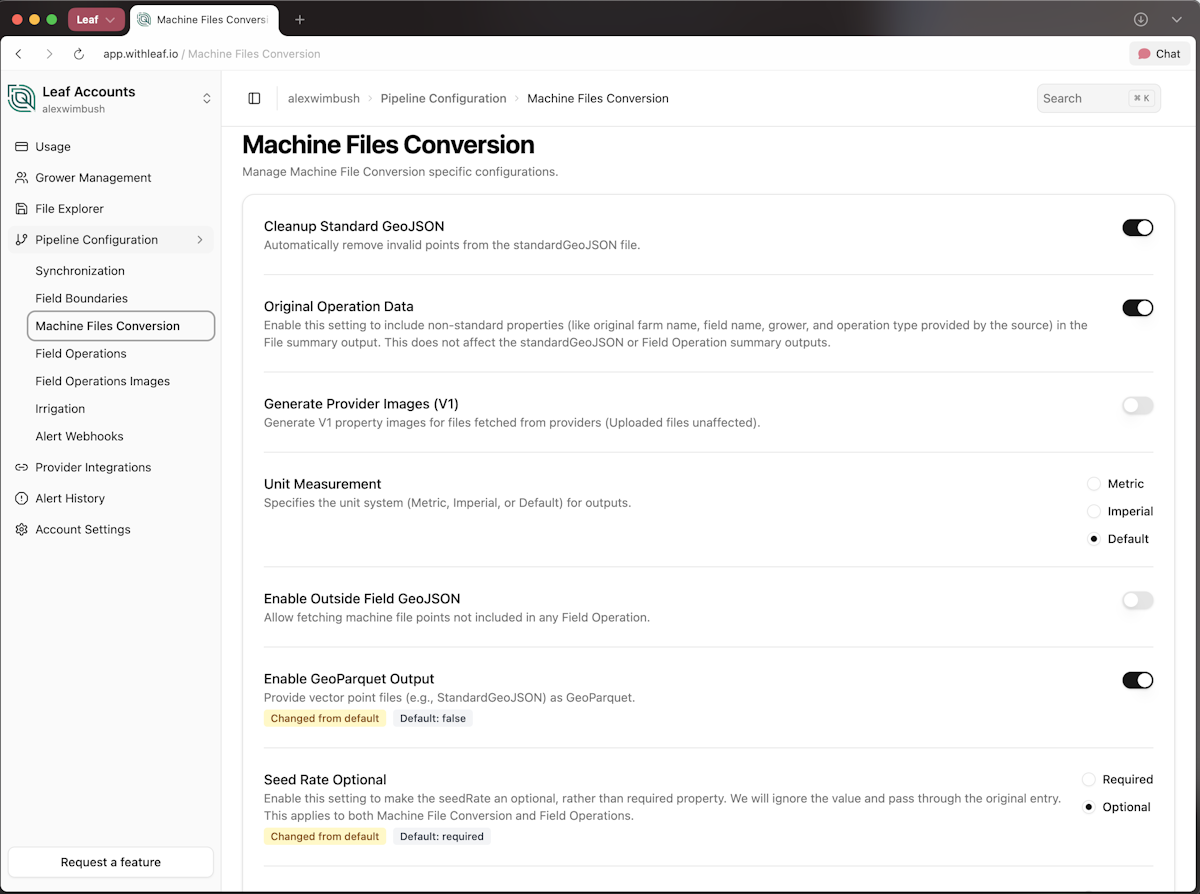
[Image of Dash]
You can access the dashboard using your existing API owner credentials at app.withleaf.io.
Leaf MCP: connect your favorite AI agent to Leaf with 36 (and growing) helpful tools already defined
Leaf now has an MCP server, allowing you to connect Cursor, Claude Code, or your favorite agent or AI tool and interact with the Leaf API through it.
Think of MCP (Model Context Protocol) as a bridge that lets your favorite AI tools and agents talk directly to an API. Leaf’s MCP provides a set of pre-defined tools (36 and growing) that your AI can use to interact with everything you have in Leaf. This means you can leverage the power of AI to automate tasks, gain insights, and manage your agricultural data more efficiently, all through an interface your AI agent understands.
Please contact us if you’d like to give it a try and we’ll walk you through the steps.
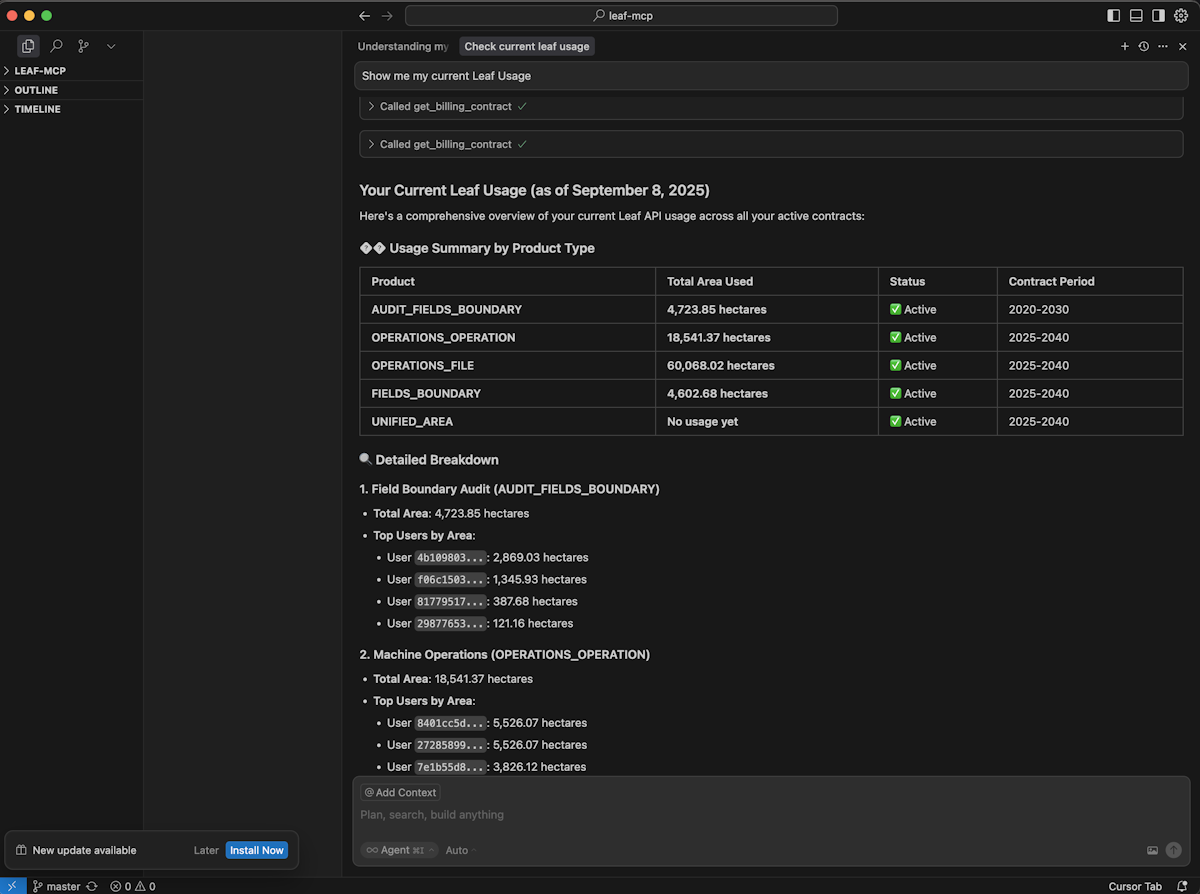
[Image of MCP via Cusor]
Looking Ahead
While the harvest data is rolling in this fall, we’ll already be working on the next batch of improvements, and as always, we’d like to hear from you what would make your life easier and your product better.
Drop us a line on Slack or contact your customer success manager. And if you want to enable any of these new features (especially the high-def GeoParquet), just reach out. Some of these require a quick configuration change on our end, and we're happy to help you get set up.
P.S. What else did we do this summer?
Between the 1000+ releases, 5+ machine data formats enhanced and 10+ features developed, our servers might not have gotten any time off, but members of our team did.








Summary
New configs: seedRateOptional, cropOptional
New properties: passCount and passID
New APIs: usage monitoring, file traceability, polygon output
Improvements to file conversion for ISO11783, AgLeader, JD, DAT, and Raven FMIS file formats
High-def data: section level details and polygon output for detailed visualizations
Configurable data sampling (e.g. 1hz)
Variety and crop name inference
Numerous improvements to files and operations: summaries, tank mixes, forage support
The kids are back in school, football season has kicked off, and everyone is asking the question: “So, what did you do this summer?”
The Leaf team was busy this summer. We shipped over 1,000 updates across our platform all designed to make it faster and easier for you to drive end-grower value with the agricultural and machine data you rely on Leaf for. In time for harvest season, your data processing through Leaf should be more powerful, more flexible, and more reliable than it was in June. Check out the highlights below:
More customer data
Flexible data configurations
We’ve introduced two new configuration options that let you decide what’s required and what’s optional which means more data being processed and fewer support calls asking “why didn’t my file go through?”
seedRateOptional: Your planting data won’t get rejected if seed rate information is missing. This is important if you are connecting growers who may not have seed meters, yet still want to track the occurrence and spatial extent of planting events.
cropOptional: Your planting data won’t get rejected if crop information is missing. Many growers planting small grains or air seeded crops don’t record crop information in their monitor – now you can process it through Leaf just as easily as all the corn and soybean data that generally does have crop.
Improvements to file conversion including agata, ISO11783, Raven FMIS, DAT, and many more
We started off the summer upgrading our pipelines to use a newly released JD converter (we actually discovered the bug/issue that, thankfully, they then fixed - Thanks JD!). We then made numerous improvements to ISO11783 (ISOXML), Raven FMIS, JD, DAT, AgData and other file formats to handle more ag data edge cases, improve telemetry accuracy, and enhance standardization (especially with respect to as-applied operations). There’s nothing you need to do to enable these improvements. We want your files just to work, and regardless of which equipment produced them, our team of experts is constantly tweaking, updating, and making file conversion better and faster for you.
Improvements to files and operations including better summaries, tank mix support, forage operations
Based on your feedback we’ve made numerous improvements to both files and operations. Application data from a planting operation is now summarized in the planting summary. We’ve made a number of improvements to how tank mixes are calculated. Forage operations are now supported.
New Properties to Track Passes
Regardless if the monitor records it, Leaf now provides the passID on each datapoint in the standardGeojson and standardGeoparquet files as well as the passCount in the summary. These are useful if you want to visualize and help your customer understand their operational efficiency, detect overlaps and control costs. Contact us to enable this feature.

[passID visualized with the new Leaf Dash]
Standardized data interval sampling
If your pipelines expect measurement data at a common interval, say 1 feature per second (1hz), you can now configure Leaf to automatically resample your data to that interval. Contact us to enable this feature.
Variety and crop name inference
By enabling this feature, we’ll attempt to infer what hybrid/variety and crop is actually represented in the data and will augment the standardGeojson with the results of our model including confidence scores. Contact us for additional details or to enable this feature.
Increased Pipeline Transparency, Faster Support
Understand why files were not processed
When a file doesn’t process because of configurations that you have enabled, we now tell you exactly which filtering rule caused the file to not process. You can now use these messages to adjust your configurations and optimize your data processing according to your app and systems’s expectations.
For example, if the the file contained points where RecordingStatus was always Off and you have cleanupStandardGeojson set to true, you’ll now see that the file failed because of “no points passed the filter: recordingStatus == On”, telling you that no points had RecordingStatus On. You might consider turning off cleanUpStandardGeojson by setting it to false if you want these points to be processed and retained.
If you are seeing lots of messages for planting data about “missing properties: seedRate” you might want to consider setting seedRateOptional to true. Or you might want to investigate with your customers why they are sending planting data with no seed rates.
If you are seeing lots of messages for “unsupported operation type: data collection” and you want this data in your app, you might consider setting outOfStandardOperations to true.
Trace files from OEM through Leaf
Ever wonder, "where did this data come from and what happened to it?" Our new file tracing endpoints give you a complete audit trail from raw file at the OEM to final processed data. Contact us to access these endpoints.
New High Definition (HD) Data
Remember how your TV got way better when you upgraded to 4K? Inspired by one of our customers and building on our release of GeoParquet support last year, we did something similar for machine data. We now support:
High definition (HD) output generation
Where the recorded data supports section-level differences in recording attributes (generally planting data) you can now get these section-level values via our standardGeojson and standardGeoparquet outputs. Please talk to us if you’d like to enable HD data for your account.
Polygon output generation
Instead of receiving point data, by setting enablePolygonOutput to true, you can now access data in polygon format. Because of the file size and complexity that comes with polygons, this is only available in GeoParquet so as to keep processing for you (and us) as efficient as possible. Once enabled, you can access polygon output using /files/{id}/polygonGeoparquet.
Between HD output and polygons you can create razor-sharp images of operations – especially planting operations where data is often recorded at a very granular level. Just like when you switched to 4K, you’ll never want to see lower-resolution images again (or give them to your customers). See below for some examples.

[Standard Definition Points - Planted]

[High Definition Points - Planted]

[High Definition Polygons - Planted Zoomed In]

[High Definition Polygons - Planted Zoomed Out]
Beyond APIs: New Ways to Interact with Leaf
We know not all of our customers are software developers and that not all workflows are best served by APIs. We’ve been hard at work building out new ways to interact with Leaf, for humans and AI agents alike.
Leaf Dash: browse and manage your data visually – stop downloading files to SMS or QGIS
With the launch of our new dashboard, you can now interact with our APIs and all of your data, growers, and configurations using a clean, modern and intuitive interface. Our early adopters, and especially their support teams, love how:
- It’s easy it is to visualize and inspect point level data without having to download files to SMS or QGIS
- They can efficiently find data across growers, files, and operations without having to use Postman. Just put in an ID into the comprehensive search box and quickly access what you need.
- They can quickly understand and edit details of their Leaf integration including their pipeline processing configurations, webhook alerts, provider integrations and monitor data processing usage.



[Image of Dash]
You can access the dashboard using your existing API owner credentials at app.withleaf.io.
Leaf MCP: connect your favorite AI agent to Leaf with 36 (and growing) helpful tools already defined
Leaf now has an MCP server, allowing you to connect Cursor, Claude Code, or your favorite agent or AI tool and interact with the Leaf API through it.
Think of MCP (Model Context Protocol) as a bridge that lets your favorite AI tools and agents talk directly to an API. Leaf’s MCP provides a set of pre-defined tools (36 and growing) that your AI can use to interact with everything you have in Leaf. This means you can leverage the power of AI to automate tasks, gain insights, and manage your agricultural data more efficiently, all through an interface your AI agent understands.
Please contact us if you’d like to give it a try and we’ll walk you through the steps.

[Image of MCP via Cusor]
Beyond APIs: New Ways to Interact with Leaf
Looking Ahead
While the harvest data is rolling in this fall, we’ll already be working on the next batch of improvements, and as always, we’d like to hear from you what would make your life easier and your product better.
Drop us a line on Slack or contact your customer success manager. And if you want to enable any of these new features (especially the high-def GeoParquet), just reach out. Some of these require a quick configuration change on our end, and we're happy to help you get set up.
P.S. What else did we do this summer?
Between the 1000+ releases, 5+ machine data formats enhanced and 10+ features developed, our servers might not have gotten any time off, but members of our team did.









